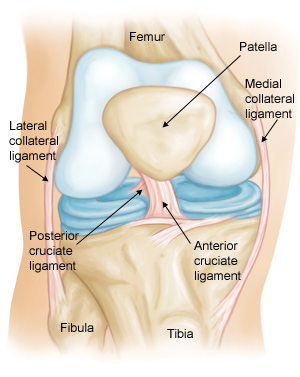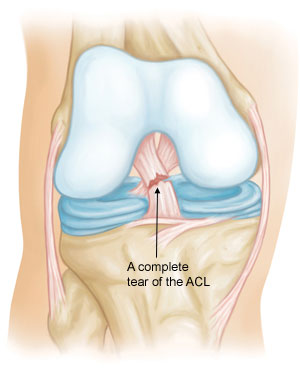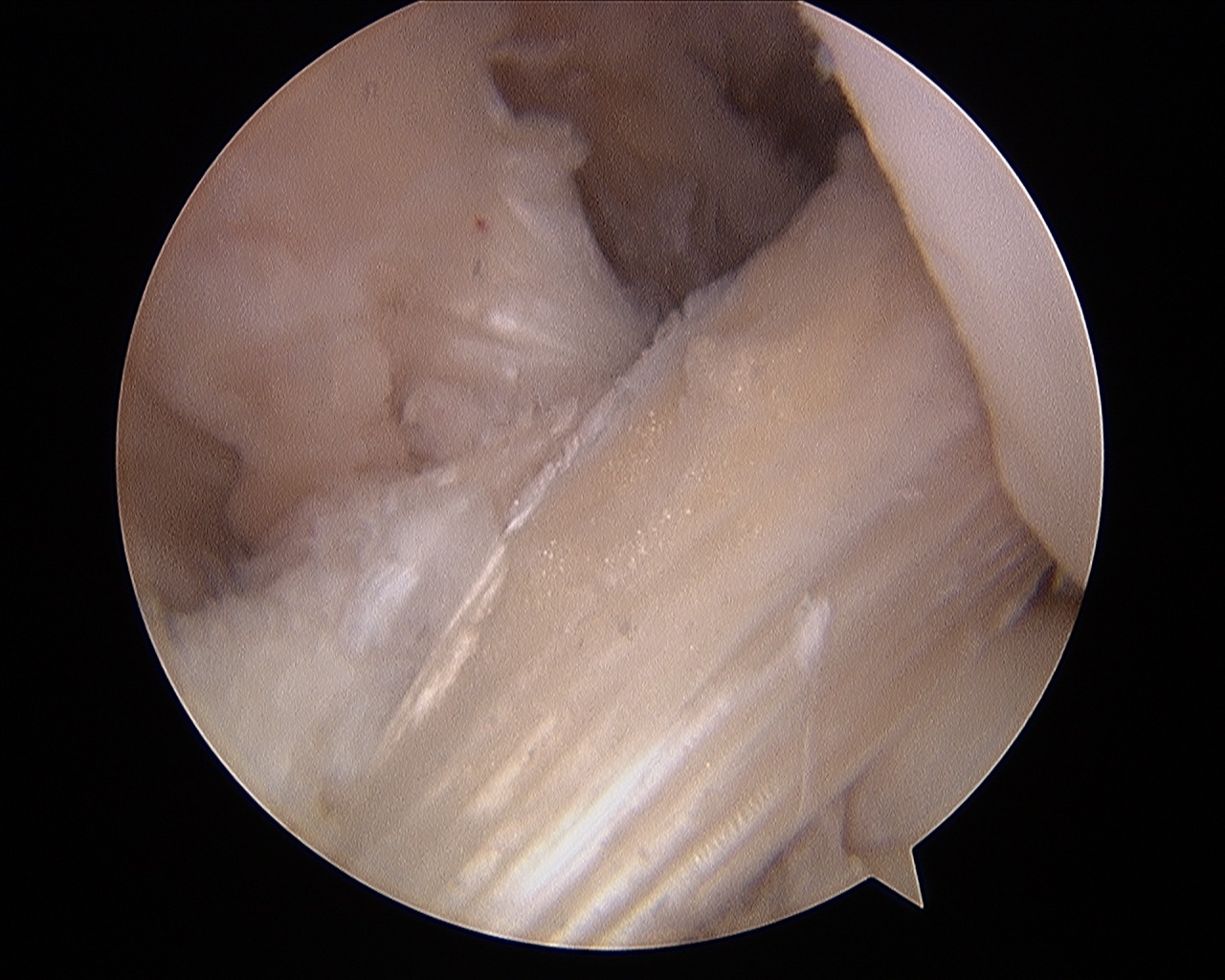Background
The anterior cruciate ligament or ACL is the main stabilizing ligament inside the knee. It is very important in providing rotational support when the athlete is doing pivoting type sports, and is commonly injured during athletic activities.. As the number of people participating in pivoting type sports increases, so to does the incidence of ACL injury. The most common sports in which you will see this injury will be basketball, soccer, and of course, football.
Anatomy
If you draw a line from side to side, then one from front to back on the knee, the ACL is right in the center of the knee where these 2 lines intersect. It is a big, strong ligament in the notch, or center, of the knee next to the PCL. It keeps the lower bone, the tibia, from rotating and translating on the upper bone or femur.
Causes of ACL tears
The major cause of ACL tears are participating in pivoting type sports. It typically happens as a non-contact, planting the foot then changing direction. This action happens over and over during basketball, soccer, and especially football activities. Unfortunately, it can be the same move the athlete has made thousands of times before. The forceful twisting and sometimes hyperextension of the knee at high speed causes the ACL the fair suddenly. This can be an obvious injury with a loud pop, pain, and immediate swelling, or occasionally be a more subtile injury in which the athlete feels a shift in the knee, but no real pain.
Female athletes get a lot more ACL injuries in relation to the time they are participating. In basketball, it can be 6 – 8 times more than males when the amount of time playing is factored in. Many theories exist why females seem to be more susceptible. Leg alignment, smaller ACL, hormonal differences, different neuromuscular training have been studied. A big effort has been made to better understand the higher risk of ACL tears in females, and perhaps to guide off-season preventative training through plyometrics and Sportsmetrics.
In summary, when an athlete sustains an ACL tear, there is nothing particular they did wrong. It is just dumb, bad luck.
Symptoms
What happened?
The classic symptoms of an acute ACL tear are that the athlete planted their foot to change direction. Their knee shifted and they felt a pop. This caused pain in the knee and it began to swell the same day. The acute swelling is from bleeding with the joint from the ligament tear. The ACL doesn’t have pain nerve ending, so the torn ligament may not hurt. Pain often comes from injury to other structures in the knee that occurs when the ACL tears and the knee shifts. When just the ACL tears, it may not hurt so much and the swelling can settle down after a week or two.
ACL tears don’t heal by themselves, though, and the athlete will be left with an ACL deficient knee. There may be no symptoms during regular, daily activities. A return to pivoting sports, however, may cause symptoms of recurrent instability or giving way. These giving way episodes are not good for the knee and additional internal damage such as meniscus tears and articular cartilage damage can happen each time the knee shifts.
Diagnosis
What’s next?
The history and physical examination is probably the most important tool in diagnosing a ruptured or deficient ACL. So it is important to get in quickly to your orthopedic sports medicine specialist to go
over what happened to you and to go through a knee examination. When an athlete presents with the history of a non-contact, plant, twist, pop, with immediate swelling in the joint, there is an 80% chance there is an ACL torn. Some people will aspirate these knees to see if there is blood. I find this part of the exam to be less important, and I only pull blood off the knee if it is so swollen that I feel the distension of the knee is causing pain. The knee also needs to evaluated for possible combined ligament injuries more than just the ACL.
X-Rays of the knee to rule out a fracture may also be ordered on the initial examination. Ligaments and tendons do not show up on x-rays, but bleeding into the joint also occurs when a fracture through the knee joint is present, or when portions of the joint surface are chipped off.
An MRI or magnetic resonance imaging study is usually ordered to confirm the diagnosis suspect on initial exam. The MRI can also visualize any meniscus tears or other damage in the joint. When an ACL tears initially, there is about a 50% chance one of the 2 meniscus pads got torn too. The MRI can be done early in the work-up of the knee injury sometimes before a good exam is possible due to pain and guarding. Please insist on going over the results of your MRI with your treating surgeon. Good quality MRI images allow the athlete and their family to see for themselves exactly what has happened inside the injured knee.
Treatment
What are your options?
Video of Dr. Maffet performing ACL reconstruction here. New technique of stem cell treatment in ACL reconstruction discussed here. Discussion of pediatric ACL injuries here.
Initial treatment for an ACL injury is focused on letting the acutely injured knee settle down and feel better. Crutches, ice, and activity modification are important.
A pre- ACL protocol should then be started. The goal of this is to regain lower leg function that is lost acutely with the injury. The swelling must be treated. Range of motion exercises started. Gait training to allow more mobility with or without the crutches. Most importantly, early quadriceps muscle rehab is started. The quad controls the entire leg. So when it quits working, nothing works right. Physical therapy is often started at this stage to assist the athlete in recovering from the injury itself.
The first decision involves whether the injured athlete wants to have the ACL tear surgically reconstructed, or whether they want to eliminate pivoting type sports. The danger with an ACL deficient knee is the returning to pivoting sports such as tennis, basketball, football, or soccer without a functioning ACL in the knee, risks additional shifting episodes and additional damage to the knee. Untreated, these shifting episodes tear up the knee a little bit more each time they happen and can lead to early knee arthritis. If the patient is wanting to return to these type of activities, the most conservative thing to do would be to surgically stabilize the knee so no additional shifting episodes happen.
I am often asked whether an ACL brace would be sufficient to allow a return to pivoting sports without surgery on the ACL. Unfortunately, many well done studies show that an ACL brace does not control the high speed, rotational motion in pivoting sports for which a functioning ACL is needed. We use ACL braces, but these are used in the post-operative, surgically stabilized knee to assist in return to sports activities.
I think that the selection of an ACL surgeon is very important. There are different options in ACL graft types and fixation methods. A surgeon familiar with all of them will allow him to select the procedure best for your individual situation. This is not a ” one size fits all” operation. The basics are that the ACL cannot be sewn back together, but must be replaced with a new one made from tendon material. The tendon acts as scaffolding for a new ligament to develop This procedure is done as an arthroscopic, minimally invasive type procedure in an outpatient surgery setting.
The common ACL grafts used are the patellar tendon autograft which uses the middle one-third of the patient’s patellar tendon with a block of bone off the patella on one end and a block of bone off it’s tibial insertion on the other end. This is a popular graft used for many years with a great deal of success. Tunnels are created at the bone insertion sites of the old ACL inside the knee with the arthroscope. The bone plugs are secured in these tunnels with the patella tendon substituting for the torn ACL. It is a great procedure in the right patient.
Another type of ACL graft involves taking the medial hamstring tendons through a small anterior incision and using these to replacement the torn ACL. Very little residual problems occur when these
tendons are used. Fixation methods inside the knee are a little different than with the bone plugs. Exhaustive studies show similar results long term whether a patellar tendon or hamstring graft is used. Again, I feel that certain athletes are better serve with these hamstring grafts, and some will do better with a patellar tendon.
The last option in ACL graft selection involves an allograft. These are donor tendons that are harvested from organ donors, sterilized, and stored frozen. ACL reconstruction with these graft has the advantage of no tissue being taken from the patient during surgery to make the new ACL. Again, I feel there are advantages and potential disadvantages of each of these options. These options should be carefully discussed with your ACL surgeon prior to scheduling the surgery.
After surgery, a standard ACL protocol with physical therapy will be started. These post-op rehab protocols can be found on this website separately. The patient typically will be allowed to weight-bear immediately with their ACL reconstructed on crutches. A postop, hinged knee brace is used the first 3 weeks postop when the patient is up. Most activities in the gym are allowed by 3 – 6 weeks. Running by 3 months. Sport-specific drills by 4 – 5 months. Return to competitive sports can begin by 6 months. One has to look at this as a year-long process.


